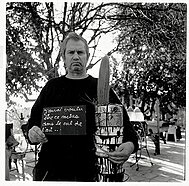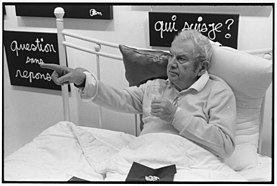Ben Vautier
Ben Vautier | |
|---|---|
 Benjamin Vautier in 2013 | |
| Born | Benjamin Vautier 1935 (age 85–86) Naples, Italy |
| Nationality | French |
| Known for | Lettrism, Performance art |
| Movement | Fluxus, zero |
Ben Vautier, also known simply as Ben[1] (born July 18, 1935 in Naples, Italy), is a French artist. Vautier lives and works in Nice, where he ran a record shop called Magazin between 1958 and 1973.
Biography[]
Benjamin Vautier was born July 18, 1935 in Naples, Italy to a French family. He is the great-grandson of the Swiss painter (1829-1898).
He discovered Yves Klein and the Nouveau Réalisme in the 1950s, but he became quickly interested in the French dada artist Marcel Duchamp and the music of John Cage. In 1959, Vautier founded the journal Ben Dieu.[2] In 1960, he had his first one-man show, Rien et tout in Laboratoire 32.
Ben joined George Maciunas in the Fluxus artistic movement,[3] in October 1962.
He is also active in Mail-Art and is mostly known for his text-based paintings or écritures began in 1953, with his work Il faut manger. Il faut dormir. Another example of the latter is "L'art est inutile. Rentrez chez vous" (Art is Useless, Go Home). A notable work made for Harald Szeemann's Documenta 5 exhibition in 1972 shouts, “KUNST IST ÜBERFLÜSSIG” (English: Art is Superfluous), and was installed across the top of the Fridericianum museum in Kassel, Germany.[4]
He has long defended the rights of minorities in all countries, and he has been influenced by the theories of François Fontan about ethnism. For example, he has defended the Occitan language (southern France).
In 1981, he coined the name of the French art movement of the 1980s Figuration Libre (Free Figuration).
- Ben Vautier

Vautier (2007)

Vautier (2019) by Olivier Meyer

Everything is Art, (1961)
See also[]
References[]
- ^ Russell, John (1982-02-12). "Art: Return of the Once Despised 'Belle-Peinture'". The New York Times. ISSN 0362-4331. Retrieved 2021-09-14.
- ^ "Reissue of Ben Dieu (1963)". ben-vautier.com. Retrieved 2021-09-14.
- ^ Glueck, Grace (1983-02-13). "Gallery View; Some Roguish 60's Art Achieves Museum Status". The New York Times. ISSN 0362-4331. Retrieved 2021-09-14.
- ^ "Retrospective: documenta". documenta 5. Retrieved 2021-09-14.
Internal link[]
Official website[]
- (in French) Official website
- French mixed-media artists
- French contemporary artists
- Fluxus
- 1935 births
- Living people
- Artists from Nice
- 20th-century French painters
- 20th-century male artists
- French male painters
- 21st-century French painters
- 21st-century male artists
- French artist stubs


